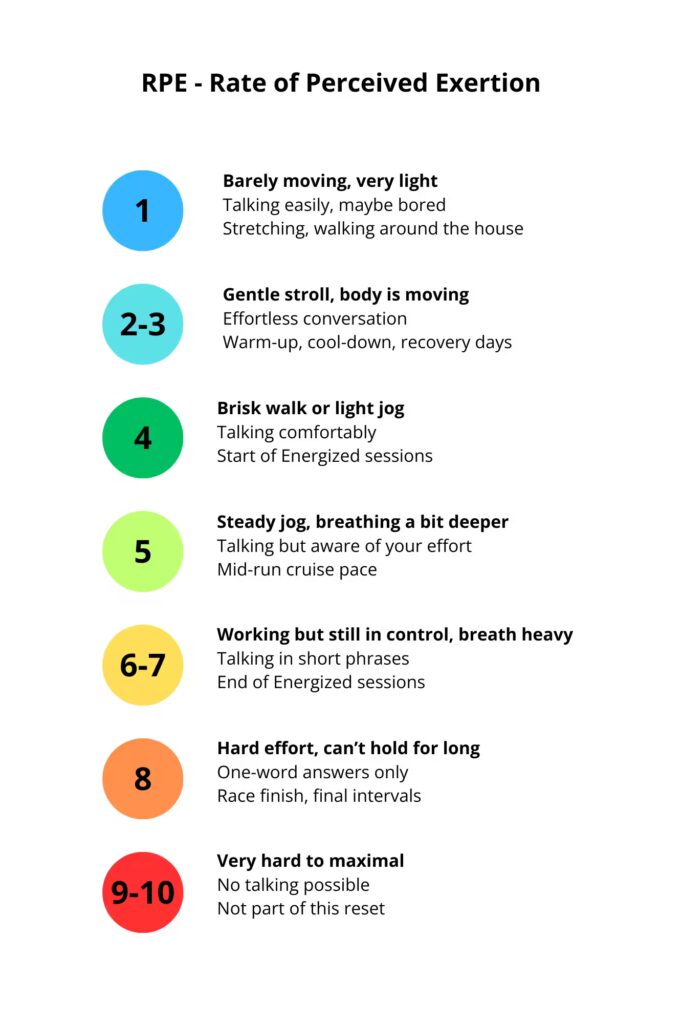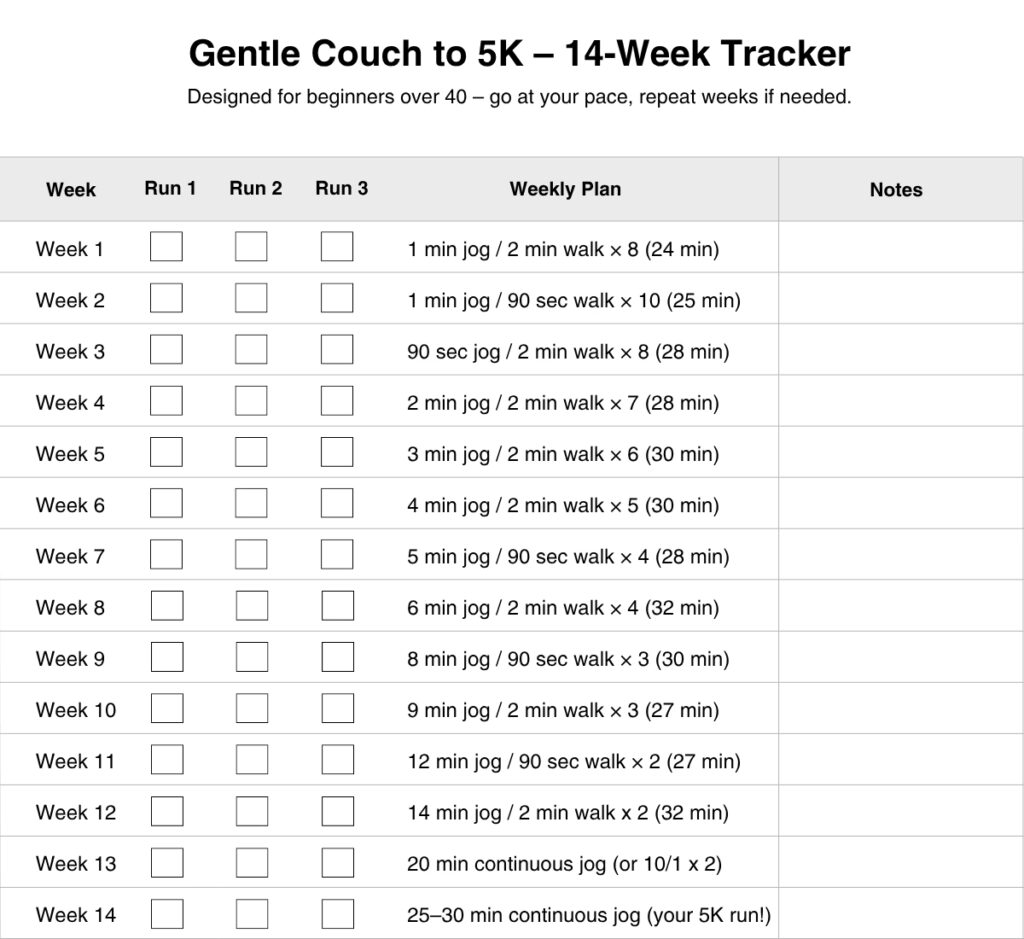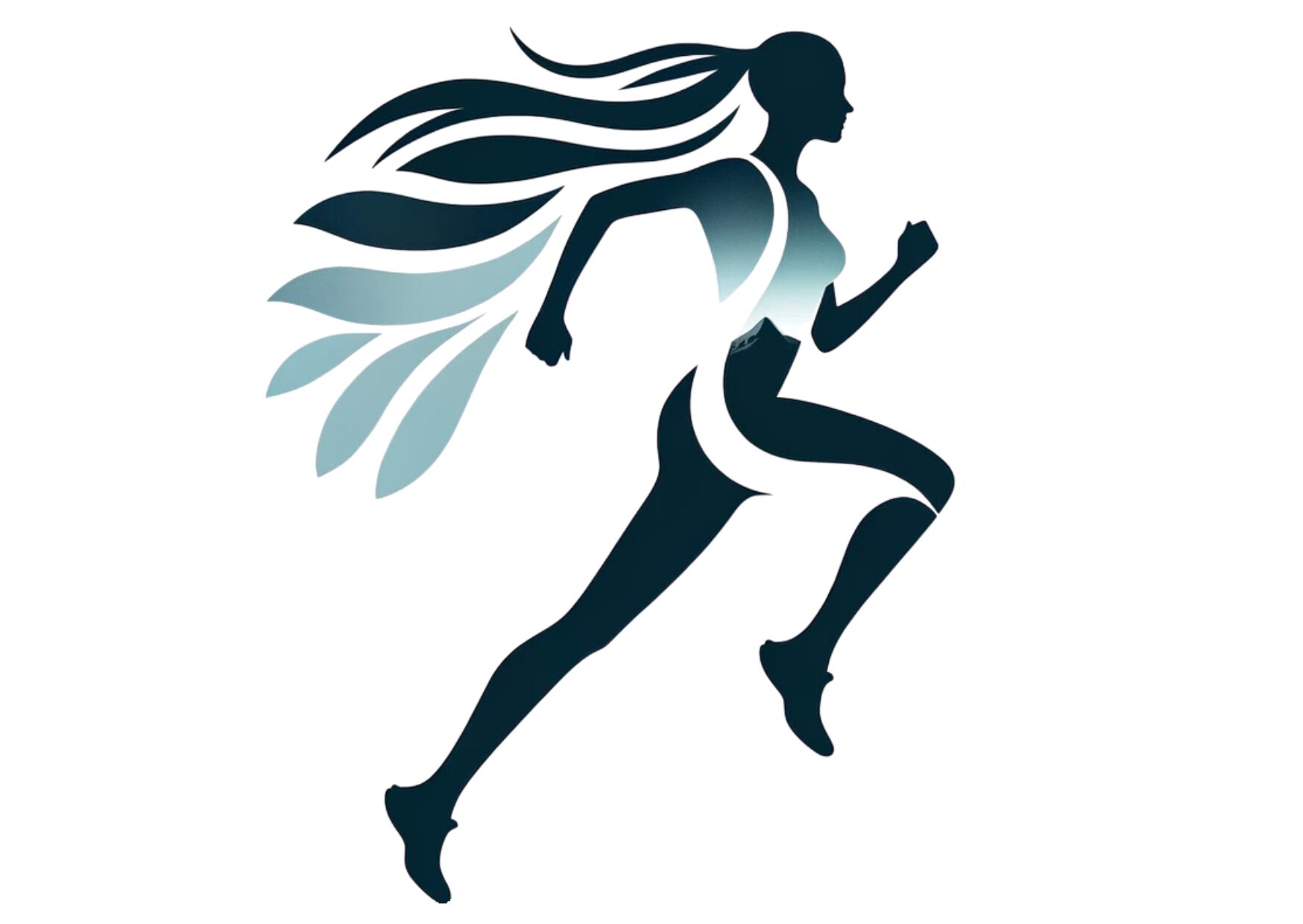About the gentle couch to 5k
If you’ve ever looked at a Couch to 5K plan and thought, “That seems a bit… intense,” you’re not alone. That’s why I decided to create a flexible and gentle “couch to 5k for beginners over 40” plan.
This gentle version was made with real life in mind, like sore knees, busy mornings, low-energy days, or those lovely hormonal changes that can throw everything off. Whether you’re in your 40s, 50s, or beyond, this plan gives you more time and more flexibility to build a running habit that sticks. Getting into shape doesn’t have to be stressful or too hard. It should be fun, it should increase your energy, and leave you full of feel-good hormones.
My goal with this plan is that you’ll be able to build something sustainable, something you’ll enjoy in the long run.
Why This Version Works
Starting (or restarting) running in your 40s or 50s is one of the best things you can do for yourself, but it also requires a little more patience and kindness toward your body. Hormones, joints, energy levels, and life responsibilities all change during midlife. A typical 9-week Couch to 5K plan might feel too rushed or too intense. Sometimes you just need more time to build up your fitness and muscles and that’s totally fine. Do it your way so that you can keep going no matter what comes in your way.
This gentle and flexible “couch to 5k for beginners over 40” plan, is designed with all of that in mind. It gives you more time to adapt, more space to listen to your body, and the freedom to repeat or pause as needed, without guilt. It’s about consistency, not perfection.
Whether you’re navigating perimenopause, balancing work and family, or simply want a slower pace, this approach is meant to support you, not stress you.
How to Use This Plan
Choose Your Pace: 12, 14, or 16 Weeks
This plan is designed to work with your life, not to stress you out. You get to decide how fast or slow you move through it, based on your current fitness level, energy, hormones, and schedule. There’s no pressure and no “falling behind.”
- 14 weeks is the default track. It’s a gentle, realistic pace for most beginners over 40, giving your body time to adapt gradually without overload.
- 12 weeks is a slightly faster track. You can use this if you already walk regularly, have some base fitness, or feel like you’re ready to move a bit quicker. To follow this track, simply skip the occasional week and jump to the next.
- 16 weeks is the extra-gentle option. It’s ideal if you’re dealing with fatigue, joint issues, menopause symptoms, or just want a plan with plenty of breathing room. You can add 2 warm-up weeks at the start, focused on brisk walking and gentle movement before transitioning into run/walk intervals.
Tip: You can also switch tracks as you go. Maybe you start on the 14-week plan, but a rough week hits. No problem. Just repeat a week or slow things down. This plan is here to support you, not rush you.
The “Repeat Weeks” Rule
Let’s be honest: life happens.
Some days your body feels off. You didn’t sleep. Work was overwhelming. Hormones are doing their thing. Or maybe you just don’t feel like running. That’s all part of being human, especially during midlife.
This plan builds in permission to take it easy when you need to. Sometimes we just need to pause, adjust, and repeat. It doesn’t mean we’re falling behind or giving up. We keep doing what we can, and pick up the pace when we feel better again.
If you miss a week, feel too tired, or just need more time, just repeat the last week. You don’t lose progress. You’re not behind. You’re listening to your body, and giving it time to adjust.
Repeat Weeks Rule:
If you’re not ready to move on, simply repeat. You can stay on any week as long as you need.
Effort Guide: RPE and the Talk Test
This plan isn’t about pushing yourself to the limit, it’s about building a healthy, sustainable habit. You’re not training for the Olympics. You’re moving your body, boosting your mood, and taking care of your health. That means your run/walk sessions should feel easy to moderate, not like you’re gasping for air or counting down the seconds until it’s over.
One way to keep things in check is by using the RPE scale, that’s short for Rate of Perceived Exertion. It’s a simple 1 to 10 scale based on how hard you feel you’re working.

During your run intervals, aim to be around 4 to 6 out of 10. You’re breathing deeper than usual, but still in control. You should be able to talk, maybe a little choppy, but still full sentences. If you can chat easily you’re probably going at just the right pace.
And that brings us to the talk test, a no-fuss way to measure effort:
- Can you talk but not sing? Perfect!
- Can’t get more than a word or two out? Ease up, slow your jog, or walk for a bit.
- Still belting out tunes? No problem, you’re probably walking, and that’s completely okay, too.
Remember: your pace is the right pace. It doesn’t matter what anyone else is doing. Some days you might feel strong and pick it up a bit. Other days, it’s enough just go for a walk. Both are wins.
The Plan: Walk–Run, Strength, and Recovery
Weekly Structure Example
Each week includes 3 run/walk sessions, plus options for strength and recovery:
- Monday: Rest or short mobility (gentle movement/stretching)
- Tuesday: Run/walk session
- Wednesday: Optional strength or yoga
- Thursday: Run/walk session
- Friday: Rest or light walk
- Saturday: Run/walk session (your “longer” effort of the week)
- Sunday: Rest or light mobility
This is just an example. Do it the way that fits into your life.
Warm-Up and Cool-Down
Each session should begin and end with intention:
- Warm-up: 5–8 minute brisk walk + a few gentle mobility moves (hip circles, ankle rolls, arm swings, leg swings).
- Cool-down: 5-minute easy walk + light stretching (calves, hamstrings, hips).
These small additions can dramatically reduce injury risk and help you recover, especially as your body becomes more sensitive to stress and impact with age.
The 14 Week “Couch to 5k” Training Plan
Here’s Your Gentle 14-Week “Couch to 5K for Women Over 40” Plan
Below is the week-by-week plan designed for beginners over 40. It’s structured to build endurance gradually, protect your joints, and help you feel stronger with each step.
You’ll start with short intervals of walking and jogging, and slowly work up to running for 30 minutes. If you’re just getting started, feel free to walk more and repeat any week as needed.

Click here to download the training plan
Final Thoughts
People are different. Some can train for a 5k in 8 weeks, others need 20 weeks or more. Some people have a good baseline from other activities, while others don’t. Some people have health issues and need to start slow because of that. Some people just lose motivation if they go too fast.
It doesn’t matter how you do it; just start where you are and keep going. Progress is personal.
This plan is here to support you. Whether you walk more than you run, need to repeat weeks, or take extra rest days, you’re still moving forward.
Running after 40 isn’t about chasing your younger self.
It’s about becoming your strongest, most grounded version, right now.
Enjoy the process and celebrate the little wins.
You’ve got this.
FAQ: Gentle Couch to 5K
1. What if I can’t run the full intervals, should I stop?
Not at all!
This plan is about progress, not perfection. If you need to walk more than run, that’s okay. You can repeat the same week as many times as you need until it feels easier. Every step counts, and walking is still moving forward.
2. Can I still do this if I’m completely out of shape?
Yes, absolutely.
If you’re starting from zero, try adding 2 warm-up weeks with brisk walking before starting Week 1. This gives your body a chance to build a base and ease in without stress. Remember, this plan was created for people just like you.
3. Do I have to run 3 times a week?
That’s the ideal goal, but it’s flexible.
If you can only manage 2 sessions some weeks, that’s okay. You’ll still make progress. Life happens, just keep showing up when you can, and repeat weeks whenever you need. It’s better to go slow than to give up.
4. What kind of shoes should I wear for this plan?
Look for a comfortable, supportive running shoe that works for your feet. If possible, visit a local running store for a proper fit. Since you’re easing in gradually, cushioning and support are more important than speed or style. Check out my recommendations about running shoes for women over 40 here.
5. Will this plan help me lose weight or tone up?
It can definitely help, especially if you combine it with strength training, nutritious food, and rest. But more importantly, it will improve your energy, mood, health, and endurance.

